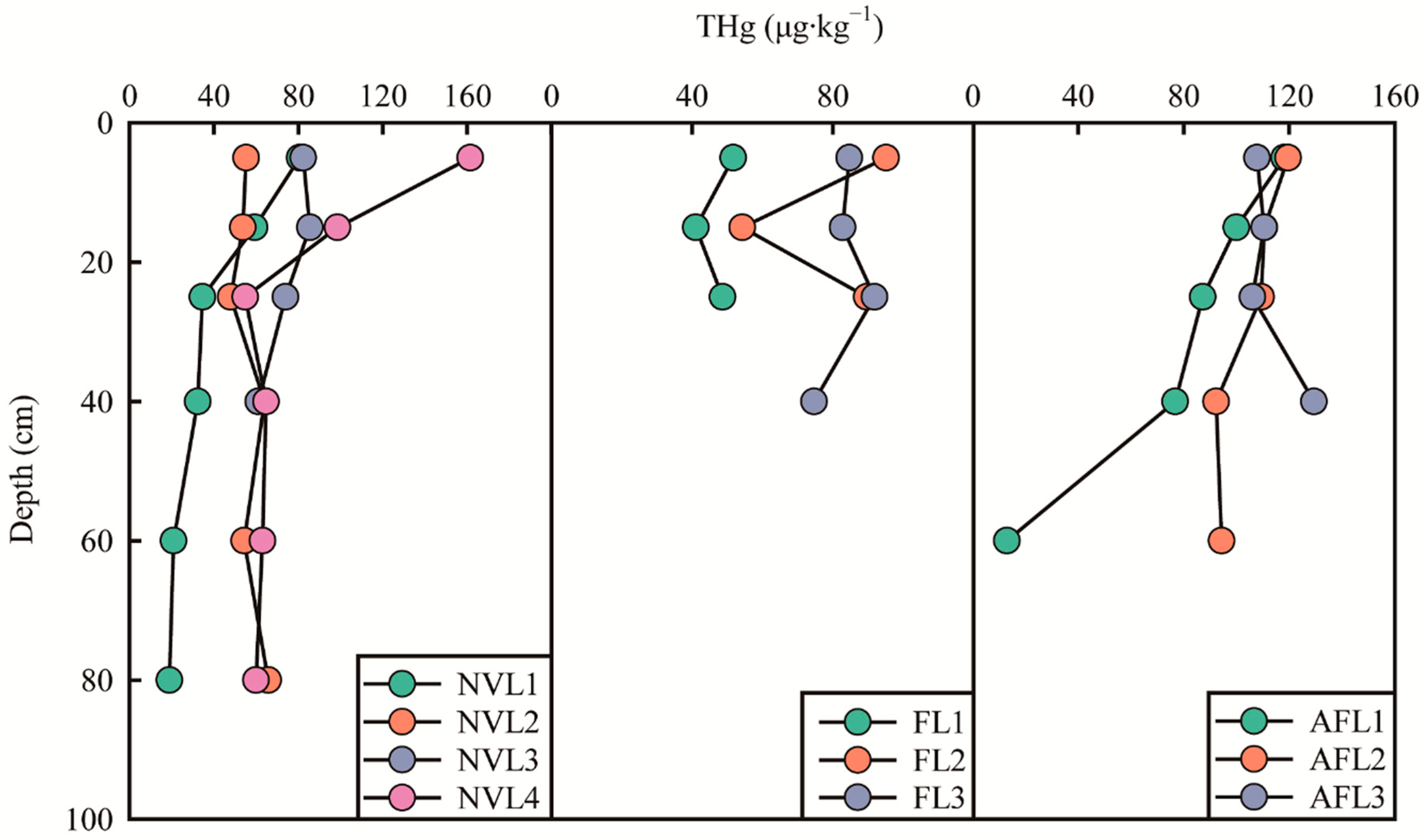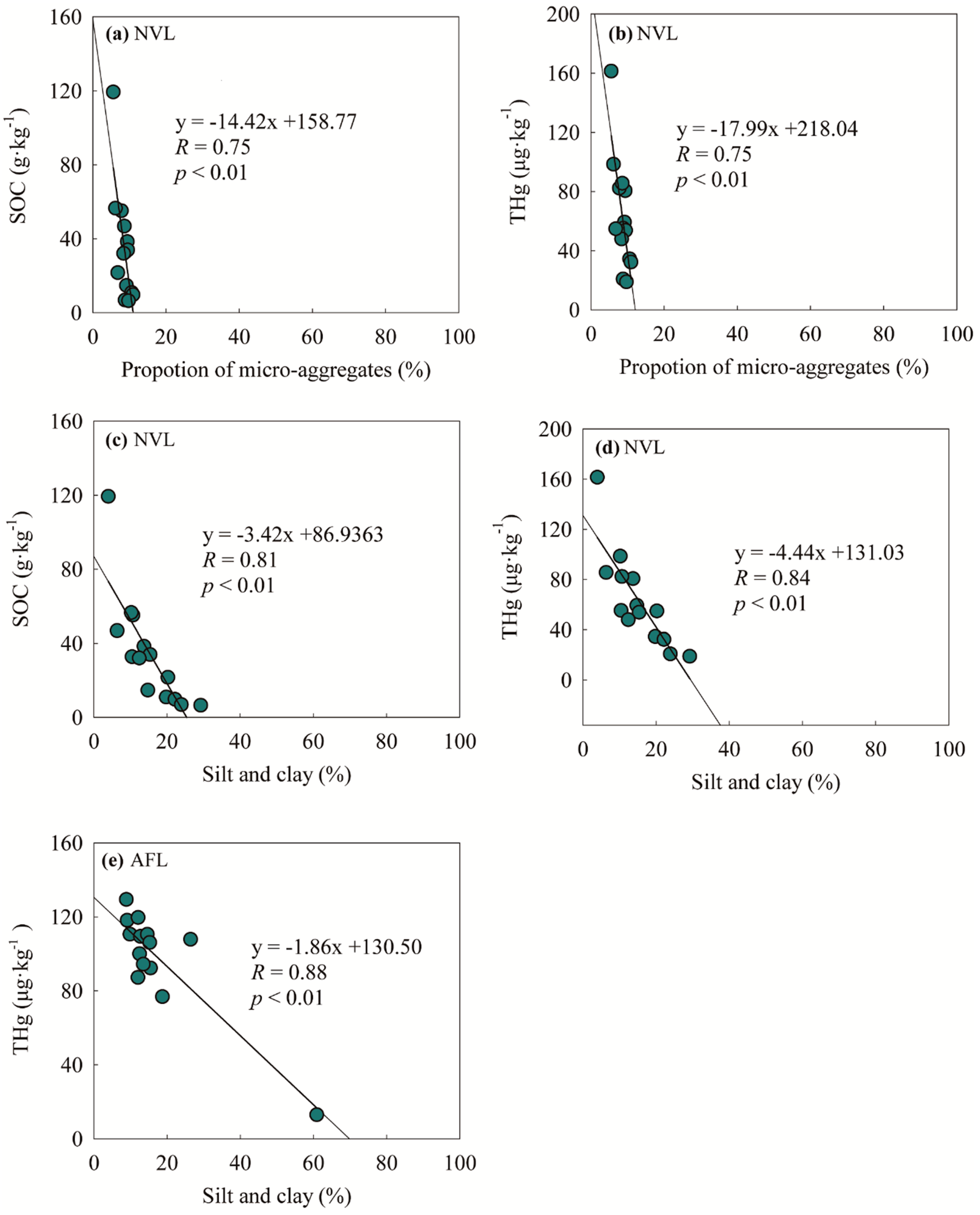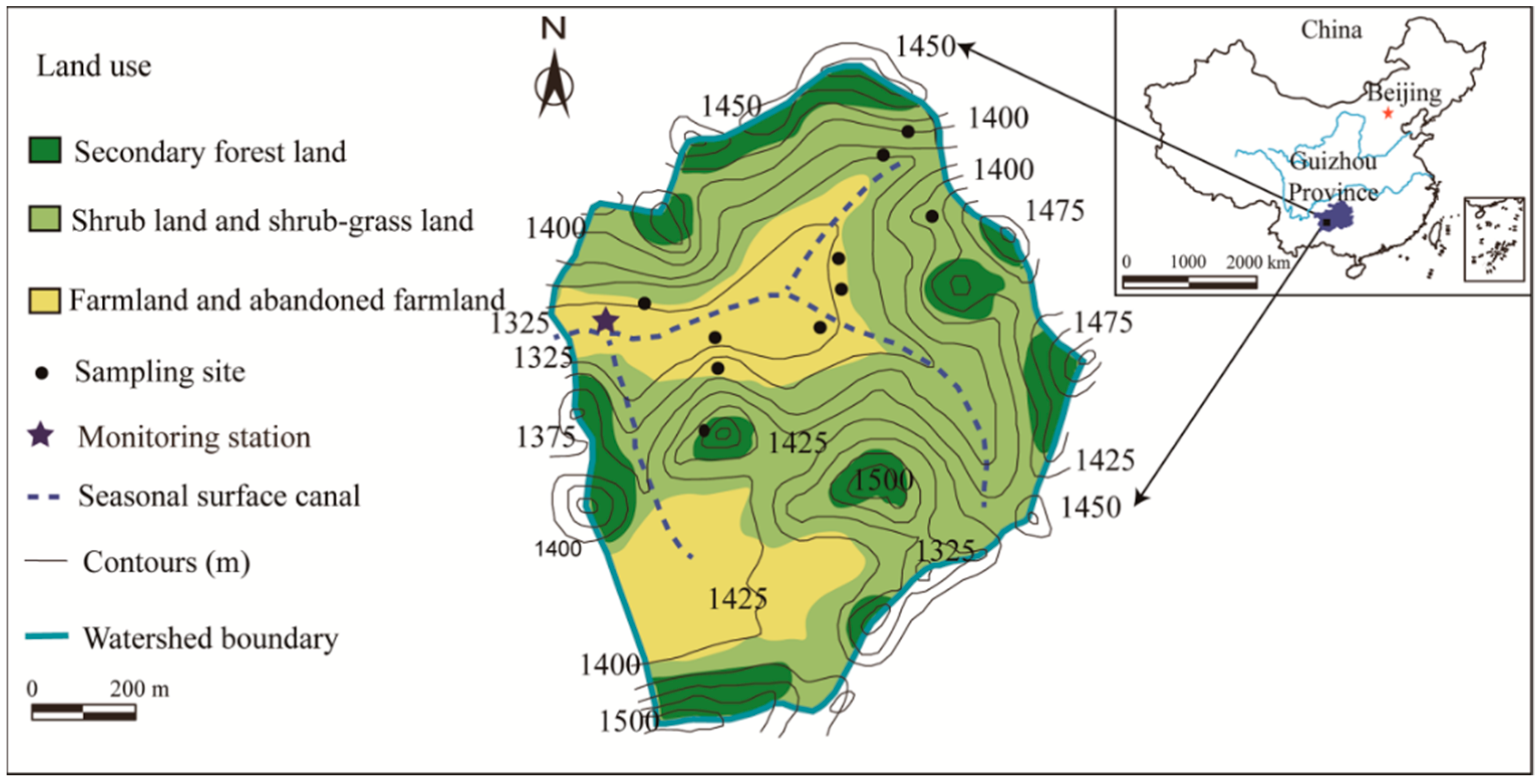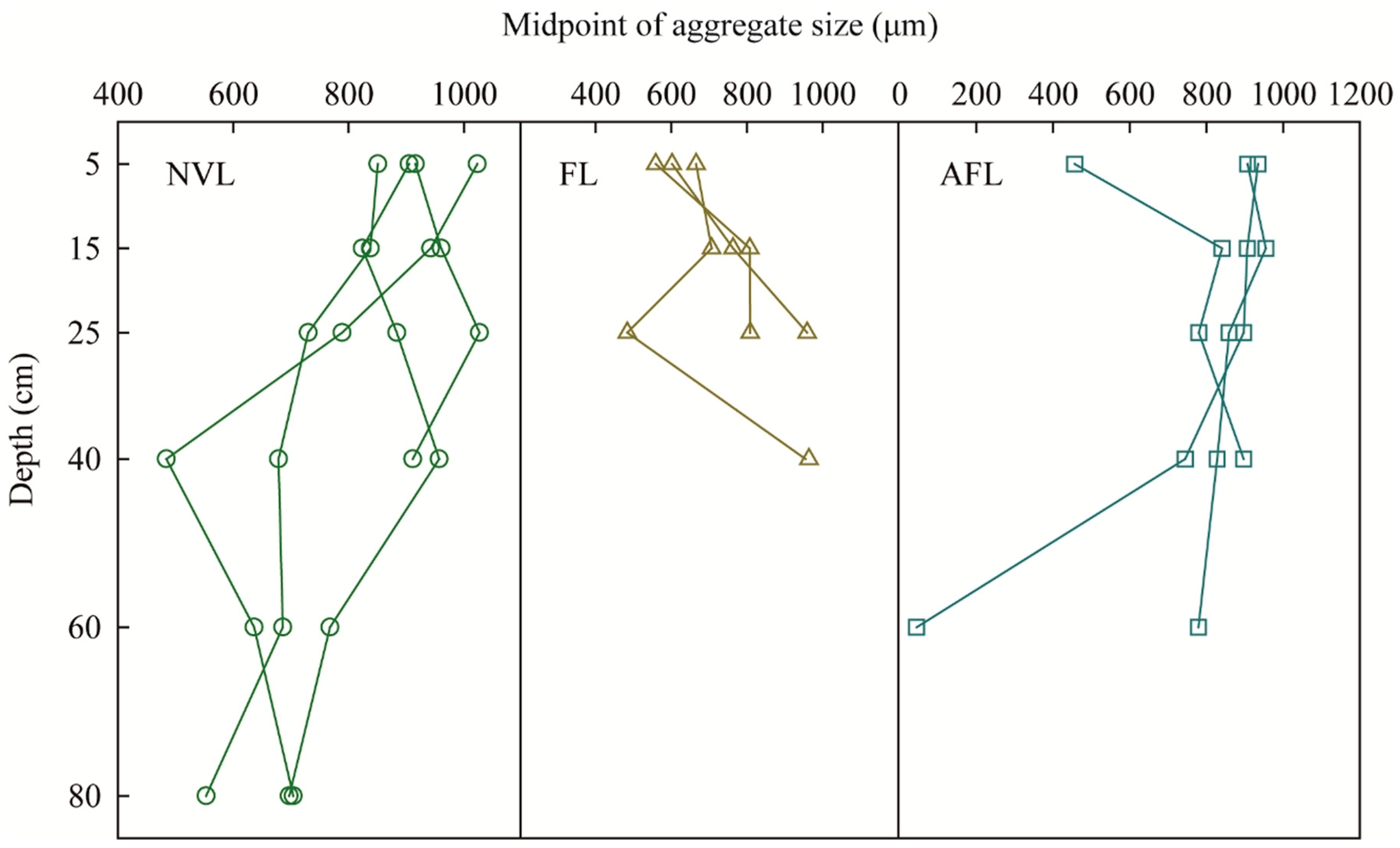The Grain for Green Project May Enrich the Mercury Concentration in a Small Karst Catchment, Southwest China
Abstract
:1. Introduction
2. Materials and Methods
2.1. Study Area
2.2. Sample Collection
2.3. Sample Analysis Methods
2.4. Statistical Analysis
3. Results and Discussion
3.1. Increased THg Concentration after Agricultural Abandonment
3.2. Effects of SOC Concentration
3.3. Effects of Soil Aggregate Size on Hg Concentrations
4. Conclusions
Author Contributions
Funding
Acknowledgments
Conflicts of Interest
Appendix A
| Profile | Depth (cm) | THg (μg∙kg−1) | SOC (g∙kg−1) | Proportion (%) | ||
|---|---|---|---|---|---|---|
| Macro-Aggregates | Micro-Aggregates | Silt and Clay | ||||
| Native vegetation land (NVL) | ||||||
| NVL1 | 5 | 80.60 | 38.40 | 76.88 | 9.41 | 13.71 |
| NVL1 | 15 | 59.30 | 14.73 | 76.04 | 9.18 | 14.78 |
| NVL1 | 25 | 34.50 | 10.89 | 69.58 | 10.61 | 19.81 |
| NVL1 | 40 | 32.30 | 9.75 | 66.87 | 10.95 | 22.18 |
| NVL1 | 60 | 20.80 | 6.80 | 67.25 | 8.83 | 23.92 |
| NVL1 | 80 | 18.90 | 6.49 | 61.07 | 9.72 | 29.21 |
| NVL2 | 5 | 55.20 | 32.80 | 80.70 | 8.84 | 10.46 |
| NVL2 | 15 | 53.70 | 33.96 | 75.12 | 9.49 | 15.39 |
| NVL2 | 25 | 47.90 | 32.03 | 79.16 | 8.42 | 12.43 |
| NVL2 | 40 | 63.90 | 22.97 | 84.72 | 6.88 | 8.39 |
| NVL2 | 60 | 54.30 | 15.65 | 71.70 | 12.88 | 15.42 |
| NVL2 | 80 | 65.70 | 10.38 | 67.82 | 15.51 | 16.67 |
| NVL3 | 5 | 82.30 | 55.15 | 81.50 | 7.81 | 10.68 |
| NVL3 | 15 | 85.50 | 46.84 | 85.03 | 8.61 | 6.37 |
| NVL3 | 25 | 73.90 | 24.72 | 90.83 | 4.65 | 4.51 |
| NVL3 | 40 | 61.00 | 12.72 | 81.15 | 10.86 | 7.98 |
| NVL4 | 5 | 161.40 | 119.33 | 90.47 | 5.58 | 3.95 |
| NVL4 | 15 | 98.50 | 56.49 | 83.56 | 6.20 | 10.24 |
| NVL4 | 25 | 54.80 | 21.69 | 72.95 | 6.80 | 20.25 |
| NVL4 | 40 | 64.70 | 8.03 | 58.28 | 8.27 | 33.44 |
| NVL4 | 60 | 63.00 | 4.28 | 64.79 | 10.26 | 24.95 |
| NVL4 | 80 | 59.90 | 4.62 | 68.19 | 13.58 | 18.23 |
| Farmland (FL) | ||||||
| FL1 | 5 | 51.70 | 16.42 | 61.30 | 16.93 | 21.77 |
| FL1 | 15 | 41.10 | 22.85 | 74.09 | 11.13 | 14.78 |
| FL1 | 25 | 48.70 | 24.69 | 74.15 | 10.58 | 15.26 |
| FL2 | 5 | 95.20 | 47.85 | 63.21 | 19.27 | 17.52 |
| FL2 | 15 | 54.30 | 45.77 | 71.43 | 15.76 | 12.81 |
| FL2 | 25 | 89.70 | 53.41 | 84.86 | 8.10 | 7.04 |
| FL3 | 5 | 84.70 | 44.03 | 66.20 | 16.52 | 17.28 |
| FL3 | 15 | 82.80 | 45.54 | 68.33 | 18.37 | 13.30 |
| FL3 | 25 | 91.90 | 46.88 | 58.27 | 20.78 | 20.95 |
| FL3 | 40 | 74.70 | 53.29 | 84.54 | 7.93 | 7.53 |
| Abandoned farmland (AFL) | ||||||
| AFL1 | 5 | 118.10 | 37.12 | 82.91 | 8.02 | 9.07 |
| AFL1 | 15 | 100.00 | 33.60 | 80.79 | 6.76 | 12.46 |
| AFL1 | 25 | 87.20 | 27.41 | 80.09 | 7.90 | 12.02 |
| AFL1 | 40 | 76.80 | 18.22 | 70.36 | 10.94 | 18.70 |
| AFL1 | 60 | 13.00 | 3.26 | 26.45 | 12.67 | 60.88 |
| AFL2 | 5 | 119.60 | 32.01 | 80.81 | 7.11 | 12.08 |
| AFL2 | 15 | 110.60 | 24.36 | 84.53 | 5.61 | 9.85 |
| AFL2 | 25 | 109.40 | 18.77 | 77.43 | 9.88 | 12.69 |
| AFL2 | 40 | 92.30 | 13.69 | 75.37 | 9.19 | 15.44 |
| AFL2 | 60 | 94.40 | 10.13 | 72.37 | 14.15 | 13.49 |
| AFL3 | 5 | 107.80 | 33.58 | 57.24 | 16.36 | 26.40 |
| AFL3 | 15 | 110.50 | 29.50 | 76.19 | 9.22 | 14.59 |
| AFL3 | 25 | 106.10 | 33.29 | 72.41 | 12.36 | 15.22 |
| AFL3 | 40 | 129.40 | 28.24 | 80.07 | 11.07 | 8.86 |


References
- Liu, Y.; Song, S.; Bi, C.; Zhao, J.; Xi, D.; Su, Z. Occurrence, distribution and risk assessment of mercury in multimedia of Soil-Dust-Plants in Shanghai, China. Int. J. Environ. Res. Public Health 2019, 16, 3028. [Google Scholar] [CrossRef] [PubMed] [Green Version]
- Driscoll, C.T.; Mason, R.P.; Chan, H.M.; Jacob, D.J.; Pirrone, N. Mercury as a global pollutant: Sources, pathways, and effects. Environ. Sci. Technol. 2013, 47, 4967–4983. [Google Scholar] [CrossRef] [PubMed]
- Bjorklund, G.; Dadar, M.; Mutter, J.; Aaseth, J. The toxicology of mercury: Current research and emerging trends. Environ. Res. 2017, 159, 545. [Google Scholar] [CrossRef] [PubMed]
- Teng, D.Y.; Mao, K.; Ali, W.; Xu, G.M.; Huang, G.P.; Niazi, N.K.; Feng, X.B.; Zhang, H. Describing the toxicity and sources and the remediation technologies for mercury-contaminated soil. RSC Adv. 2020, 10, 23221–23232. [Google Scholar] [CrossRef]
- Zhang, W.; Zhen, G.; Chen, L.; Wang, H.; Li, Y.; Ye, X.; Tong, Y.; Zhu, Y.; Wang, X. Economic evaluation of health benefits of mercury emission controls for China and the neighboring countries in East Asia. Energy Policy 2017, 106, 579–587. [Google Scholar] [CrossRef]
- Tang, Z.; Fan, F.; Deng, S.; Wang, D. Mercury in rice paddy fields and how does some agricultural activities affect the translocation and transformation of mercury–A critical review. Ecotoxicol. Environ. Saf. 2020, 202, 110950. [Google Scholar] [CrossRef]
- Yin, R.; Feng, X.; Li, Z.; Zhang, Q.; Bi, X.; Li, G.; Liu, J.; Zhu, J.; Wang, J. Metallogeny and environmental impact of Hg in Zn deposits in China. Appl. Geochem. 2012, 27, 151–160. [Google Scholar] [CrossRef]
- Selin, N.E. Global biogeochemical cycling of mercury: A review. Annu. Rev. Environ. Resour. 2009, 34. [Google Scholar] [CrossRef] [Green Version]
- Yan, J.; Wang, C.; Wang, Z.; Yang, S.; Li, P. Mercury concentration and speciation in mine wastes in Tongren mercury mining area, southwest China and environmental effects. Appl. Geochem. 2019, 106, 112–119. [Google Scholar] [CrossRef]
- Padoan, E.; Romè, C.; Ajmone-Marsan, F. Bioaccessibility and size distribution of metals in road dust and roadside soils along a peri-urban transect. Sci. Total Environ. 2017, 601, 89–98. [Google Scholar] [CrossRef]
- Sakai, N.; Alsaad, Z.; Thuong, N.T.; Shiota, K.; Yoneda, M.; Mohd, M.A. Source profiling of arsenic and heavy metals in the Selangor River basin and their maternal and cord blood levels in Selangor State, Malaysia. Chemosphere 2017, 184, 857–865. [Google Scholar] [CrossRef] [PubMed]
- Tang, Y.; Han, G.L. Characteristics of major elements and heavy metals in atmospheric dust in Beijing, China. J. Geochem. Explor. 2017, 176, 114–119. [Google Scholar] [CrossRef]
- Lv, J.; Wang, Y. PMF receptor models and sequential Gaussian simulation to determine the quantitative sources and hazardous areas of potentially toxic elements in soils. Geoderma 2019, 353, 347–358. [Google Scholar] [CrossRef]
- Li, Y.; Zhou, S.; Zhu, Q.; Li, B.; Wang, J.; Wang, C.; Chen, L.; Wu, S. One-century sedimentary record of heavy metal pollution in western Taihu Lake, China. Environ. Pollut. 2018, 240, 709–716. [Google Scholar] [CrossRef] [PubMed]
- Fernandez, A.L.; Sheaffer, C.C.; Wyse, D.L.; Staley, C.; Gould, T.J.; Sadowsky, M.J. Associations between soil bacterial community structure and nutrient cycling functions in long-term organic farm soils following cover crop and organic fertilizer amendment. Sci. Total Environ. 2016, 566–567, 949–959. [Google Scholar] [CrossRef] [Green Version]
- Zeng, J.; Han, G.; Yang, K. Assessment and sources of heavy metals in suspended particulate matter in a tropical catchment, Northeast Thailand. J. Clean. Prod. 2020, 265, 121898. [Google Scholar] [CrossRef]
- Lal, R. Soil carbon sequestration impacts on global climate change and food security. Science 2004, 304, 1623–1627. [Google Scholar] [CrossRef] [Green Version]
- Obrist, D.; Johnson, D.W.; Lindberg, S.E.; Luo, Y.; Todd, D.E. Mercury Distribution Across 14 US Forests. Part I: Spatial Patterns of Concentrations in Biomass, Litter, and Soils. Environ. Sci. Technol. 2011, 45, 3974–3981. [Google Scholar]
- Gustin, M.S.; Lindberg, S.E.; Weisberg, P.J. An update on the natural sources and sinks of atmospheric mercury. Appl. Geochem. 2008, 23, 482–493. [Google Scholar] [CrossRef]
- Poeplau, C.; Don, A.; Vesterdal, L.; Leifeld, J.; Van Wesemael, B.; Schumacher, J.; Gensior, A. Temporal dynamics of soil organic carbon after land-use change in the temperate zone–carbon response functions as a model approach. Glob. Chang. Biol. 2011, 17, 2415–2427. [Google Scholar] [CrossRef]
- Bachmann, J.; Guggenberger, G.; Baumgartl, T.; Ellerbrock, R.H.; Urbanek, E.; Goebel, M.-O.; Kaiser, K.; Horn, R.; Fischer, W.R. Physical carbon-sequestration mechanisms under special consideration of soil wettability. J. Plant. Nutr. Soil Sci. 2008, 171, 14–26. [Google Scholar] [CrossRef]
- Han, G.L.; Li, F.S.; Tang, Y. Variations in soil organic carbon contents and isotopic compositions under different land uses in a typical karst area in Southwest China. Geochem. J. 2015, 49, 63–71. [Google Scholar] [CrossRef] [Green Version]
- Yin, R.; Gu, C.; Feng, X.; Hurley, J.P.; Krabbenhoft, D.P.; Lepak, R.F.; Zhu, W.; Zheng, L.; Hu, T. Distribution and geochemical speciation of soil mercury in Wanshan Hg mine: Effects of cultivation. Geoderma 2016, 272, 32–38. [Google Scholar] [CrossRef]
- Tisdall, J.M.; Oades, J.M. Organic matter and water-stable aggregates in soils. J. Soil Sci. 1982, 33, 141–163. [Google Scholar] [CrossRef]
- Liu, C.; Liu, Y.; Guo, K.; Zhao, H.; Qiao, X.; Wang, S.; Zhang, L.; Cai, X. Mixing litter from deciduous and evergreen trees enhances decomposition in a subtropical karst forest in southwestern China. Soil Biol. Biochem. 2016, 101, 44–54. [Google Scholar] [CrossRef]
- Zeng, J.; Han, G. Preliminary copper isotope study on particulate matter in Zhujiang River, southwest China: Application for source identification. Ecotoxicol. Environ. Saf. 2020, 196, 110663. [Google Scholar] [CrossRef]
- Liu, J.; Han, G. Effects of chemical weathering and CO2 outgassing on δ13CDIC signals in a karst watershed. J. Hydrol. 2020, 589, 125192. [Google Scholar] [CrossRef]
- Nie, L.; Liu, X.; Wang, X.; Liu, H.; Wang, W. Interpretation of regional-scale distribution of high Hg in soils of karst area in southwest China. Geochem. Explor. Environ. Anal. 2018, 19, 289–298. [Google Scholar] [CrossRef]
- Parise, M.; De Waele, J.; Gutierrez, F. Current Perspectives on the Environmental Impacts and Hazards in Karst; Springer: Berlin/Heidelberg, Germany, 2009. [Google Scholar]
- Song, X.; Peng, C.; Zhou, G.; Jiang, H.; Wang, W. Chinese Grain for Green Program led to highly increased soil organic carbon levels: A meta-analysis. Sci. Rep. 2014, 4, 4460. [Google Scholar] [CrossRef] [Green Version]
- Deng, L.; Liu, G.B.; Shangguan, Z.P. Land-use conversion and changing soil carbon stocks in China’s ‘Grain-for-Green’ Program: A synthesis. Glob. Chang. Biol. 2014, 20, 3544–3556. [Google Scholar] [CrossRef]
- Deng, L.; Shangguan, Z.-P.; Li, R. Effects of the grain-for-green program on soil erosion in China. Int. J. Sediment. Res. 2012, 27, 120–127. [Google Scholar] [CrossRef]
- Zhang, K.; Dang, H.; Tan, S.; Cheng, X.; Zhang, Q. Change in soil organic carbon following the ‘Grain-for-Green’ programme in China. Land Degrad. Dev. 2010, 21, 13–23. [Google Scholar] [CrossRef]
- Wang, B.; Gao, P.; Niu, X.; Sun, J. Policy-driven China’s Grain to Green Program: Implications for ecosystem services. Ecosyst. Serv. 2017, 27, 38–47. [Google Scholar] [CrossRef]
- Zeng, J.; Han, G. Tracing zinc sources with Zn isotope of fluvial suspended particulate matter in Zhujiang River, Southwest China. Ecol. Indic. 2020, 118, 106723. [Google Scholar] [CrossRef]
- Zhang, Q.; Han, G.; Liu, M.; Liang, T. Spatial distribution and controlling factors of heavy metals in soils from Puding Karst Critical Zone Observatory, southwest China. Environ. Earth Sci. 2019, 78, 279. [Google Scholar] [CrossRef]
- Wu, Q.; Han, G.; Tao, F.; Tang, Y. Chemical composition of rainwater in a karstic agricultural area, Southwest China: The impact of urbanization. Atmos. Res. 2012, 111, 71–78. [Google Scholar] [CrossRef]
- Yang, R.; Zhao, M.; Zeng, C.; Chen, B.; Liu, Z. Spatiotemporal variations of Soil CO2 in Chenqi, Puding, SW China: The effects of weather and LUCC. In Hydrogeological and Environmental Investigations in Karst Systems; Springer: Berlin/Heidelberg, Germany, 2015; pp. 191–205. [Google Scholar]
- Han, G.; Li, F.; Tang, Y. Organic matter impact on distribution of rare earth elements in soil under different land uses. Clean–Soil Air Water 2017, 45, 1600235. [Google Scholar] [CrossRef]
- Zeng, J.; Yue, F.-J.; Wang, Z.-J.; Wu, Q.; Qin, C.-Q.; Li, S.-L. Quantifying depression trapping effect on rainwater chemical composition during the rainy season in karst agricultural area, southwestern China. Atmos. Environ. 2019, 218, 116998. [Google Scholar] [CrossRef]
- Zhao, M.; Zeng, C.; Liu, Z.; Wang, S. Effect of different land use/land cover on karst hydrogeochemistry: A paired catchment study of Chenqi and Dengzhanhe, Puding, Guizhou, SW China. J. Hydrol. 2010, 388, 121–130. [Google Scholar] [CrossRef]
- Midwood, A.J.; Boutton, T.W. Soil carbonate decomposition by acid has little effect on δ13C of organic matter. Soil Biol. Biochem. 1998, 30, 1301–1307. [Google Scholar] [CrossRef]
- Kachurina, O.M.; Zhang, H.; Raun, W.R.; Krenzer, E.G. Simultaneous determination of soil aluminum, ammonium- and nitrate-nitrogen using 1 M potassium chloride extraction. Commun. Soil Sci. Plant. Anal. 2000, 31, 893–903. [Google Scholar] [CrossRef]
- Han, G.; Tang, Y.; Liu, M.; Van Zwieten, L.; Yang, X.; Yu, C.; Wang, H.; Song, Z. Carbon-nitrogen isotope coupling of soil organic matter in a karst region under land use change, Southwest China. Agric. Ecosyst. Environ. 2020, 301. [Google Scholar] [CrossRef]
- Liu, M.; Han, G.; Zhang, Q. Effects of agricultural abandonment on soil aggregation, soil organic carbon storage and stabilization: Results from observation in a small karst catchment, Southwest China. Agric. Ecosyst. Environ. 2019, 288, 106719. [Google Scholar] [CrossRef]
- Li, X.; Han, G.; Zhang, Q.; Miao, Z. Optimal separation method for high-precision K isotope analysis by using MC-ICP-MS with a dummy bucket. J. Anal. At. Spectrom. 2020, 35, 1330–1339. [Google Scholar] [CrossRef]
- Six, J.; Elliott, E.; Paustian, K.; Doran, J. Aggregation and soil organic matter accumulation in cultivated and native grassland soils. Soil Sci. Soc. Am. J. 1998, 62, 1367–1377. [Google Scholar]
- Qu, R.; Han, G.; Liu, M.; Li, X. The Mercury Behavior and Contamination in Soil Profiles in Mun River Basin, Northeast Thailand. Int. J. Environ. Res. Public Health 2019, 16, 4131. [Google Scholar] [CrossRef] [Green Version]
- Ding, Z.; Wang, W.; Li, Q.U.; Tang, Q.; Liu, C.; Cheng, J.; Wei, H.U. Mercury Pollution and Its Ecosystem Effects in Wanshan Mercury Miner Area, Guizhou. Environ. Sci. 2004, 25, 111. [Google Scholar]
- Wei, H.; Fan, W.; Wang, X.; Lu, N.; Dong, X.; Zhao, Y.; Ya, X.; Zhao, Y. Integrating supply and social demand in ecosystem services assessment: A review. Ecosyst. Serv. 2017, 25, 15–27. [Google Scholar] [CrossRef]
- Gao, P.; Niu, X.; Wang, B.; Zheng, Y. Land use changes and its driving forces in hilly ecological restoration area based on gis and rs of northern china. Sci. Rep. 2015, 5, 11038. [Google Scholar]
- Paul, K.I.; Polglase, P.J.; Nyakuengama, J.; Khanna, P. Change in soil carbon following afforestation. For. Ecol. Manag. 2002, 168, 241–257. [Google Scholar]
- Laganiere, J.; Angers, D.A.; Pare, D. Carbon accumulation in agricultural soils after afforestation: A meta-analysis. Glob. Chang. Biol. 2010, 16, 439–453. [Google Scholar]
- Nouvellon, Y.; Epron, D.; Kinana, A.; Hamel, O.; Mabiala, A.; D’Annunzio, R.; Deleporte, P.; Saint-André, L.; Marsden, C.; Roupsard, O. Soil CO2 effluxes, soil carbon balance, and early tree growth following savannah afforestation in Congo: Comparison of two site preparation treatments. For. Ecol. Manag. 2008, 255, 1926–1936. [Google Scholar]
- Six, J.; Elliott, E.T.; Paustian, K. Soil macroaggregate turnover and microaggregate formation: A mechanism for C sequestration under no-tillage agriculture. Soil Biol. Biochem. 2000, 32, 2099–2103. [Google Scholar] [CrossRef]
- Schlesinger, W.H. Carbon balance in terrestrial detritus. Annu. Rev. Ecol. Syst. 1977, 8, 51–81. [Google Scholar] [CrossRef]
- Skyllberg, U.; Bloom, P.; Qian, J.; Lin, C.-M.; Bleam, W. Complexation of Mercury(II) in Soil Organic Matter: EXAFS Evidence for Linear Two-Coordination with Reduced Sulfur Groups. Environ. Sci. Technol. 2006, 40, 4174–4180. [Google Scholar] [CrossRef]
- Hesterberg, D.; Chou, J.; Hutchison, K.; Sayers, D. Bonding of Hg(II) to Reduced Organic Sulfur in Humic Acid As Affected by S/Hg Ratio. Environ. Sci. Technol. 2001, 35, 2741–2745. [Google Scholar] [CrossRef]
- Qian, J.; Skyllberg, U.; Frech, W.; Bleam, W.; Bloom, P.; Petit, P. Bonding of methyl mercury to reduced sulfur groups in soil and stream organic matter as determined by X-ray absorption spectroscopy and binding affinity studies. Geochim. Cosmochim. Acta 2002, 66, 3873–3885. [Google Scholar] [CrossRef]
- Dermont, G.; Bergeron, M.; Mercier, G.; Richer-Laflèche, M. Soil washing for metal removal: A review of physical/chemical technologies and field applications. J. Hazard. Mater. 2008, 152, 1–31. [Google Scholar]
- Qu, R.; Han, G.; Liu, M.; Yang, K.; Li, X.; Liu, J. Fe, Rather Than Soil Organic Matter, as a Controlling Factor of Hg Distribution in Subsurface Forest Soil in an Iron Mining Area. Int. J. Environ. Res. Public Health 2020, 17, 359. [Google Scholar]
- Pant, P.; Allen, M. Interaction of soil and mercury as a function of soil organic carbon: Some field evidence. Bull. Environ. Contam. Toxicol. 2007, 78, 539–542. [Google Scholar]
- Palmieri, H.E.; Nalini Jr, H.A.; Leonel, L.V.; Windmöller, C.C.; Santos, R.C.; de Brito, W. Quantification and speciation of mercury in soils from the Tripuí Ecological Station, Minas Gerais, Brazil. Sci. Total Environ. 2006, 368, 69–78. [Google Scholar] [CrossRef] [PubMed] [Green Version]
- Cesário, R.; Hintelmann, H.; O’Driscoll, N.J.; Monteiro, C.E.; Caetano, M.; Nogueira, M.; Mota, A.M.; Canári, J. Biogeochemical Cycle of Mercury and Methylmercury in Two Highly Contaminated Areas of Tagus Estuary (Portugal). Water Air Soil Pollut. 2017, 228, 257. [Google Scholar]
- Cesário, R.; Monteiro, C.E.; Nogueira, M.; O’Driscoll, N.J.; Caetano, M.; Hintelmann, H.; Mota, A.M.; Canário, J.o. Mercury and Methylmercury Dynamics in Sediments on a Protected Area of Tagus Estuary (Portugal). Water Air Soil Pollut. 2016, 227, 475. [Google Scholar] [CrossRef]
- Monteiro, C.E.; Cesário, R.; O’Driscoll, N.J.; Nogueira, M.; Válega, M.; Caetano, M.; Canário, J. Seasonal variation of methylmercury in sediment cores from the Tagus Estuary (Portugal). Mar. Pollut. Bull. 2016, 104, 162–170. [Google Scholar] [CrossRef] [PubMed]
- Ruan, Y.; Xiangdong, L.I.; Tinyu, L.I.; Chen, P.; Lian, B. Heavy Metal Pollution in Agricultural Soils of the Karst Areas and Its Harm to Human Health. Earth Environ. 2015, 43, 92–97. [Google Scholar]
- Wang, S.J.; Liu, Q.M.; Zhang, D.F. Karst rocky desertification in southwestern China: Geomorphology, landuse, impact and rehabilitation. Land Degrad. Dev. 2004, 15, 115–121. [Google Scholar] [CrossRef]
- Liu, M.; Han, G.; Zhang, Q. Effects of soil aggregate stability on soil organic carbon and nitrogen under land use change in an erodible region in Southwest China. Int. J. Environ. Res. Public Health 2019, 16, 3809. [Google Scholar] [CrossRef] [Green Version]
- Franzluebbers, A.J.; Arshad, M.A. Soil Microbial Biomass and Mineralizable Carbon of Water-Stable Aggregates. Soil Sci. Soc. Am. J. 1997, 61, 1090–1097. [Google Scholar] [CrossRef]
- Hussain, I.; Olson, K.R.; Wander, M.M.; Karlen, D.L. Adaptation of soil quality indices and application to three tillage systems in southern Illinois. Soil Tillage Res. 1999, 50, 237–249. [Google Scholar] [CrossRef]
- Li, D.; Zhang, X.; Green, S.M.; Dungait, J.A.J.; Wen, X.; Tang, Y.; Guo, Z.; Yang, Y.; Sun, X.; Quine, T.A. Nitrogen functional gene activity in soil profiles under progressive vegetative recovery after abandonment of agriculture at the Puding Karst Critical Zone Observatory, SW China. Soil Biol. Biochem. 2018, 125, 93–102. [Google Scholar] [CrossRef]
- Chavarria, D.N.; Pérez-Brandan, C.; Serri, D.L.; Meriles, J.M.; Restovich, S.B.; Andriulo, A.E.; Jacquelin, L.; Vargas-Gil, S. Response of soil microbial communities to agroecological versus conventional systems of extensive agriculture. Agric. Ecosyst. Environ. 2018, 264, 1–8. [Google Scholar] [CrossRef]
- Rabot, E.; Wiesmeier, M.; Schlüter, S.; Vogel, H.J. Soil structure as an indicator of soil functions: A review. Geoderma 2018, 314, 122–137. [Google Scholar] [CrossRef]




| Stage | Dominant Plant | Land-Use Condition |
|---|---|---|
| Native vegetation land (NVL) | Eleusine indica, Ailanthus altissima | Shrub-grass land and Mixed evergreen broadleaved deciduous forest |
| Farmland (FL) | Arachis hypogaea, Zea mays | Long-term cultivation activities, crop rotation, mixed application of fertilizer |
| Abandoned farmland (AFL) | Oxalis corniculat, Eleusine indica | Agricultural abandonment over 3–8 years, cover with shrubland or grassland |
© 2020 by the authors. Licensee MDPI, Basel, Switzerland. This article is an open access article distributed under the terms and conditions of the Creative Commons Attribution (CC BY) license (http://creativecommons.org/licenses/by/4.0/).
Share and Cite
Qu, R.; Han, G. The Grain for Green Project May Enrich the Mercury Concentration in a Small Karst Catchment, Southwest China. Land 2020, 9, 354. https://doi.org/10.3390/land9100354
Qu R, Han G. The Grain for Green Project May Enrich the Mercury Concentration in a Small Karst Catchment, Southwest China. Land. 2020; 9(10):354. https://doi.org/10.3390/land9100354
Chicago/Turabian StyleQu, Rui, and Guilin Han. 2020. "The Grain for Green Project May Enrich the Mercury Concentration in a Small Karst Catchment, Southwest China" Land 9, no. 10: 354. https://doi.org/10.3390/land9100354





